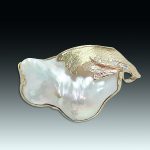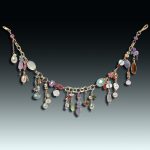
This lovely freshwater pearl accented by diamonds and set in a 14k gold pin titled, “In the Cloud,” allows artist Eve Alfillé, to indulge her imagination. Photo by Matthew Arden, courtesy Eve J. Alfillé Gallery and Studio Evanston, Illinois.
Are you a June baby who doesn’t like her birthstone? Do you still think your only choices are your grandmother’s pearls—the Queen’s pearls—round, white and boring?
Nope. Not true anymore. In fact, if you like wild colors and shapes, take another look at pearls.
Pearls have always been found in non-round shapes and colors other than white, cream. In fact, when there were only natural pearls in the world—those made without the encouragement of a human hand—round pearls were the rarities. Natural pearls form when something gets inside a mollusk—say a small parasite bores through the shell—and irritates the animals tender flesh. They begin to cover the invader with nacre, the same material that lines the inside of the mollusks shell, and that we know as “mother-of-pearl.”
The coating process isn’t an exact science, of course, so the pearls formed could come out any color, any shape, highly nacreous, or utterly meh.
Then came along Mr. Mikimoto. He inserted spherical beads of mother-of-pearl into pearl-producing oysters and, presto! Cultured pearls.
It wasn’t quite that easy, but the way cultured pearls hit the market, it felt like a knockout punch. Because cultured pearls were far less expensive, suddenly everyone could have—and did have—a strand of pearls. (Look at any yearbook from the 1940s and 1950s.)
Cultured pearls also changed public expectations. Because Mikimoto’s pearls were so perfect, they set the bar. The understanding of and appreciation for colored, out-of-round, and baroque pearls remained only among pearl aficionados.

In her light and playful “Nouveau Botticelli” bracelet, Illinois designer Eve Alfillé pairs freshwater pearls of all colors and shapes with an array of gemstones: aquamarine, citrine, prasiolite, carnelian, garnet, fluorite, moonstone, spinel, amethyst, tourmaline, tanzanite and peridot. Photo by Matthew Arden, courtesy Eve J. Alfillé Gallery and Studio Evanston, Illinois.
“Oysters, schmoysters,” said the freshwater mollusks. “They’re not the only ones who can make pearls. Watch and learn.”
When the 1960s and 70s brought a revolution against tradition, those little perfect strands went into a drawer. But then pearl lovers (naming no names, but me!) became aware of freshwater pearls being cultured in Japan, in Lake Biwa. These pearls were not cultured with beads, but with tiny pieces of mussel muscle. As a result, they weren’t round at all and the surface was often ribbed or bubbled. But the nacre was extraordinary.
Today, Lake Biwa no longer produces pearls, a victim of pollution due to toxic run off from the surrounding farms. But that hasn’t slowed the production of freshwater cultured pearls, because the Chinese have taken up the cause and changed the game. Today, they produce tons (that’s right tons) of cultured pearls in a variety of shapes, from perfectly round to slender “stick” pearls, and endless colors (often the result of dyeing or irradiation). You can find cultured freshwater pearls everywhere.
And they’re often not in strands. Jewelry artist and pearl expert Eve J. Alfillé, in Evanston, Illinois, uses pearls everywhere she can, as you can see from the definitely un-boring pieces of jewelry here.
Pearls are happening, June baby! Dive in!

No Comments